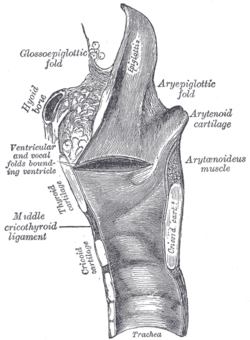Oblique arytenoid
The oblique arytenoid, the more superficial Arytenoid muscle, forms two fasciculi, which pass from the base of one cartilage to the apex of the opposite one, and therefore cross each other like the limbs of the letter X; a few fibers are continued around the lateral margin of the cartilage, and are prolonged into the aryepiglottic fold; they are sometimes described as a separate muscle, the Aryepiglotticus.
| Oblique arytenoid | |
|---|---|
 Muscles of larynx. Posterior view. Oblique arytenoid: The "X" in the center. Transverse arytenoid: Bands underneath the "X". Aryepiglotticus: Wraps around back. | |
 Sagittal section of the larynx and upper part of the trachea. (Arytenoideus visible at center right.) | |
| Details | |
| Origin | Posterior surface of muscular process of arytenoid cartilage |
| Insertion | Posterior surface of apex of adjacent arytenoid cartilage; extends into aryepiglottic fold |
| Nerve | recurrent laryngeal branch of vagus nerve [X] |
| Actions | Sphincter of the laryngeal inlet |
| Identifiers | |
| Latin | musculus arytenoideus obliquus |
| TA | A06.2.08.010 |
| FMA | 46583 |
| Anatomical terms of muscle | |
The aryepiglottic muscle together with the transverse arytenoid and the thyroarytenoid work as a sphincter and close the larynx as we swallow or cough. Its innervation is by the recurrent laryngeal nerve (from vagus) just like all the intrinsic muscles of the larynx except the cricothyroid muscle.
References
This article incorporates text in the public domain from page 1082 of the 20th edition of Gray's Anatomy (1918)
External links
- lesson11 at The Anatomy Lesson by Wesley Norman (Georgetown University) (larynxmuscles)